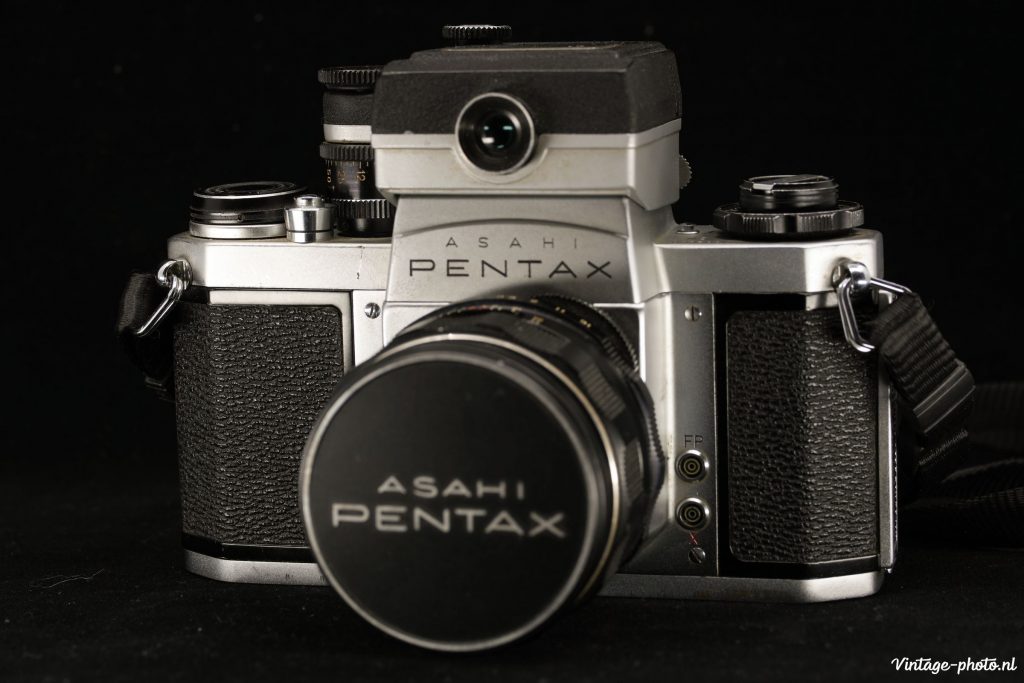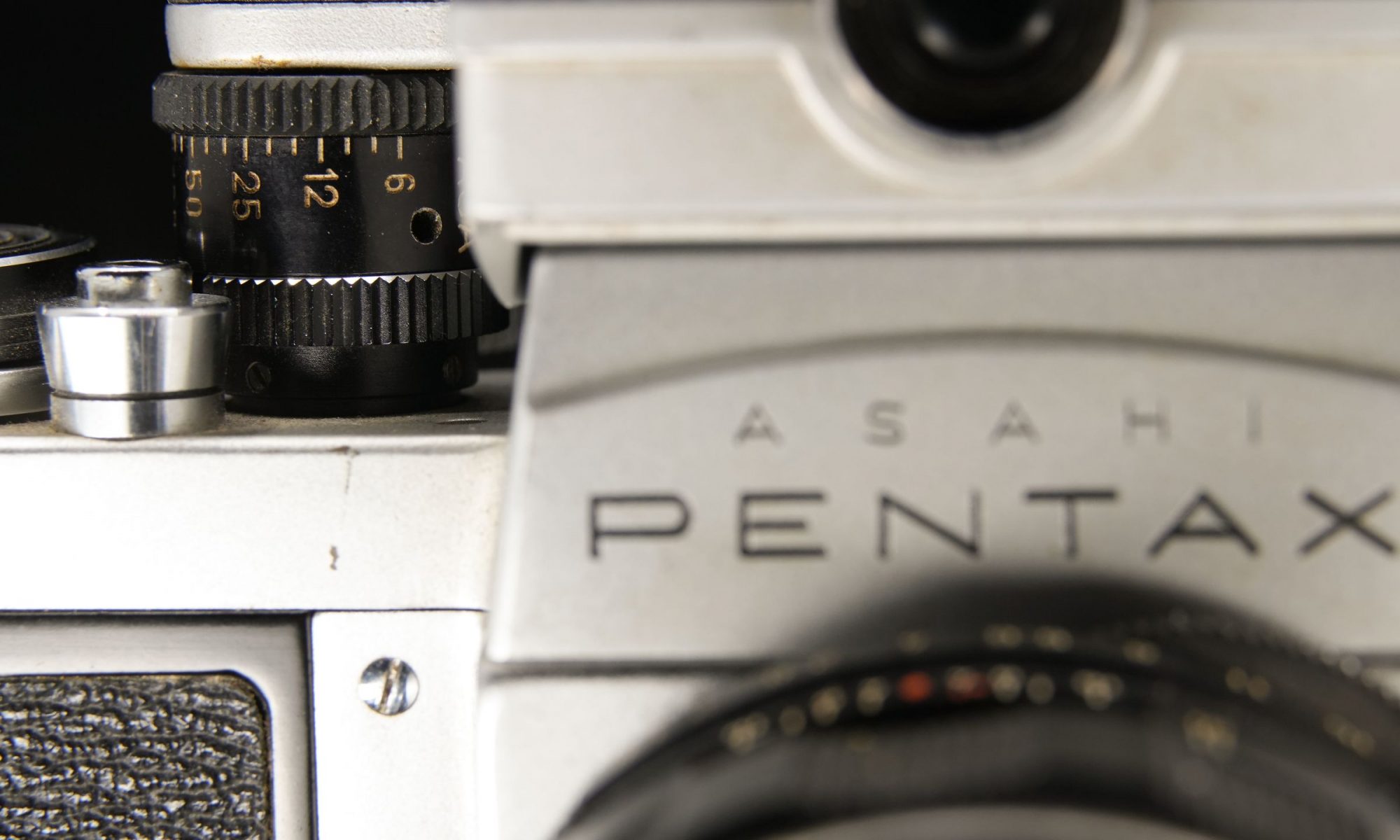Who remembers Pentax? The sympathetic camera brand for everyone, with affordable prices, good quality, but never achieving comparable status with Nikon, Canon or Minolta. The Japanese company turned just under 100 years old. Founded as Asahi Kogaku Goshi Kaisha in 1919 by and sold to Hoya and Ricoh in 2011 with in between a very long history of (especially) SLR cameras. In this review we look at a more unknown classic, a 1964 S(V).
The story goes that curiously, the Pentax name was first registered by Germany’s VEB Pentacon/Zeiss-Ikon because Asahi was not very keen on just copying key design elements of the existing Contax series and the Germans cleverly responded by “hijacking” the Japanese name of the Asahi SLR. The Japanese model from 1957 was very similar to the typical shape of the pentaprism of the Germans and they called Pentaprism _ Contax=PenTax. Fortunately, Asahi managed to buy the name (back) from Zeiss Ikon. The Asahiflex was the first SLR camera, launched in 1952. What made the Asahiflex unique was the instant return mirror. Until then, it took other brands a lot of headache to create a mirror-reflex design where the mirror returned back up immediately after the photo was taken. Asahi did succeed and it marked the starting point of the golden years of the Pentax camera. From 1957 until the first digital SLR in 2003. The most famous series became the Spotmatic and the long-running K series. Also in medium format, the brand managed to gain popularity with the famous 6×7 and 6×4.5.


The first models featured a screw-mount (mostly M42) until Pentax developed its own K-mount. The SV in this review is from the early years and sits lonely between the Asahiflex and Spotmatic. Produced from about 1963 to 1968 in chrome and black and in two successive versions, the latter having some improvements and the only visual distinction being the red instead of a green R on the rewind button. But withe the SV also Pentax lens brand Takumar introduced the Super-Takumars, that stands out by lens coating for the first time and an automatic diaphragm which not only closed the aperture to the preselected value, but after firing the shutter re-opened for focusing. This can be done by switching to A(utomatic) or ‘fully open’ on the rear back of the lens. To this day, the (Super-) Takuma lenses are still eagerly purchased by fans and easily adapted for various brands. The high glass quality is definitely not inferior to the lenses of Nikon and Canon and in some cases even better!


Think e.g. of the SMC Pentax 50mm f1.4. but certainly also the 55mm F1.8, reviewed here and still extremely popular. Back to the rare SV, the lone ranger between two famous models. My particular SW stands out because of the exposure meter as a clip on on top of the camera. This was not standard, but a nifty accessory powered by a Mallory PX13B battery that can still be purchased today as WeinCell MRB625. There are also alternatives, but make sure the voltage is exactly 1.35V, otherwise the meter will give wrong values! Also nice is that the exposure meter is directly linked to the ASA/ISO settings, something that the camera itself cannot do. The ASA/ISO dial on the camera is just a reminder.
For its age, the SV already has real features of the later, advanced SLR cameras. Striking is its robustness, an all-metal camera with sturdy dials, indestructible. But what particularly struck me is that the shutter speeds are still extremely accurate after all these years. Something that leaves much to be desired with other cameras of the same age. Speaking of shutter speeds, the SV may be praised for its fast 1/1000s for its time. The other times go back to 1s and Bulb. The camera also has an ingenious self-timer located in the rewind knob. Turning it to the left winds up the timer and the small button next to it can be used to start the countdown.


The camera is completed by a film counter and a fast single stroke winding mechanism. The viewfinder is extremely bright due to the advanced pentaprism that Asahi itself describes as the jewel in the camera with 25 different surfaces. The micro-prism should also be commended. When focusing, this prism gives excellent contrast. The camera has two flash connections, the well-known synchronised X (1/50s) and FP for flashbulbs with higher shutter speeds. Furthermore, the camera has prevention against double exposure, it can also be deliberately turned off to take creative photos. The manual describes how to do this.
No lack of variation in lenses, in 1964 there was already a list of 24 Takumar lenses, ranging from 18mm wide angle to 1000mm telephoto. Remarkable is also the enormous amount of system accessories for different purposes, from extension tubes, slide copiers, bellows units, microscope adapters, magnifiers, closeup lenses etc.


The 35mm camera is entirely manual and has a focal plane shutter (cloth). The weight is also lighter than comparable models from that time, partly because the camera has the typical smaller ‘Pentax design’. The camera feels ergonomic well, it handles natural for a professional SLR.
Although the SV is a real collectors item, I personally would recommend to add a more modern and advanced Spotmatic to your collection. It directly succeeds the SV but has a lot of convenience and (more) reliability to offer and still has the M42 mount which allows for hundreds of lenses of different brands. But then again, I had a Spotmatic and using this SV for the first time gave me much more feeling of owning a classic, vintage camera with this rare clip on lightmeter. And in the end, most is about look and feel.



I purchased my Spotmatic in 1970 (used).
I immediately treasured it for many years.
I too have a Pentax SV with the clip-on meter: my first SLR purchased used in 1971, and used for many years. I still have it + an assortment of SuperTakumar M42 lenses and 2 other Pentax SLR bodies and a Pentax K5 DS + another assortment of more modern lenses. The best thing is that all the lenses I have for the SLR’s still work on my DSLR even the M42’s with an adaptor of course.
Canon and Nikon were still making Leica rip offs for 2 years before they jumped on the AO Pentax SLR band wagon and copied it although much bigger and heavier. The 42mm mount often known as the universal or Pentax mount dominated the SLR market, their pre bayonet mount camera was the dominant slr and the k mount followed suit with many makes adopting it also . Mamiya did produce some SLRs but pissed about with different mounts but had great optics far superior to Nikon and canon, even Konica was way ahead of Nikon Canon in the 60s with their hexanon lenses and shutter priority mode SLRs
Interesting article, thanks. Check your work comes to mind when trying to read it though. Mentions the lens range, double exposures and the micro-prism twice amongst other stuff.
Great cameras, My first slr was an S1a. Shame AP were so late introducing their K mount; smart move to make it licence free though.
Nikon saw the potential & their F mount lasted 60+ years…
Still love using my F, F2, F3 & F4’s. Bullet proof: see this link :
https://www.flickr.com/photos/martsharm/4683329492
Just my 2 cents….